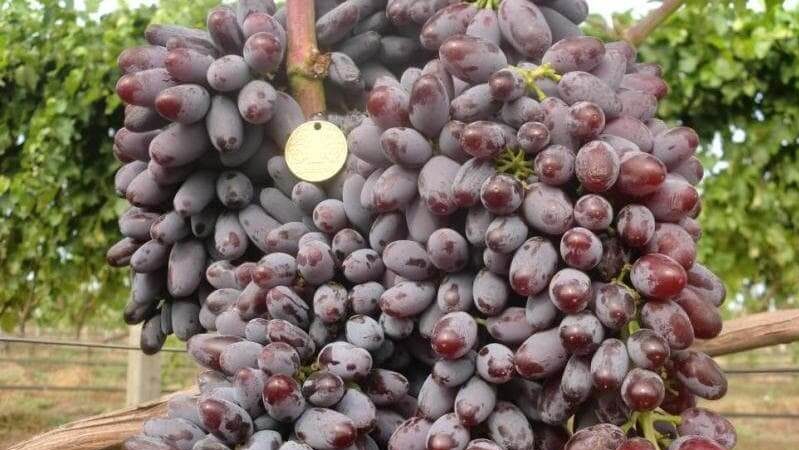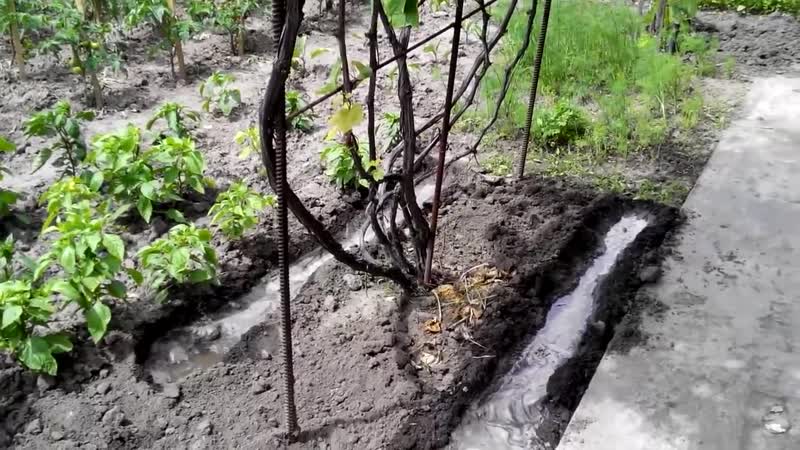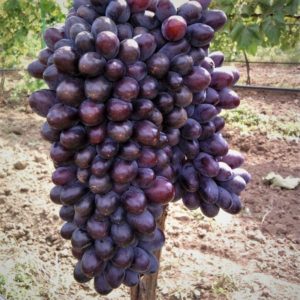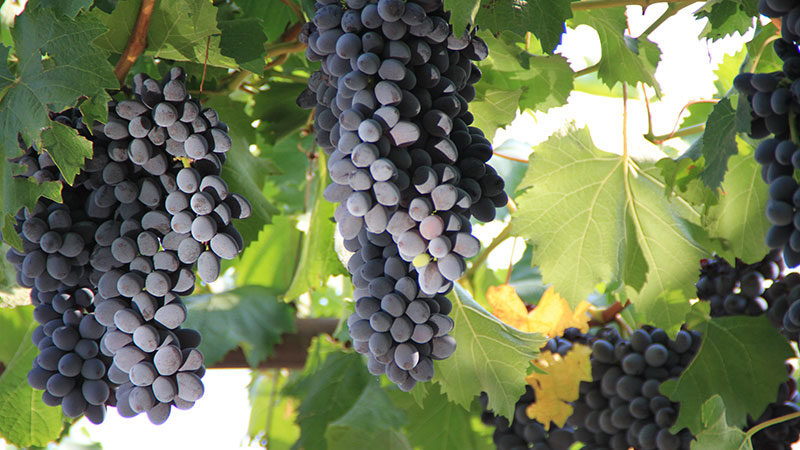Jupiter grape variety: description, advantages and disadvantages, cultivation technology
Grapes are an indispensable attribute of summer and autumn, along with melons and watermelons. Many gardeners prefer store-grown fruits and berries grown on their own plot. It is important to choose a variety that is suitable for growing in a particular region. Next, consider the popular and versatile Jupiter grape. We will find out its advantages and disadvantages, the rules of growing and care.
The content of the article
Features of the Jupiter grape
Jupiter grape - raisins, that is, small seedless grapes... It belongs to seedless table varieties, suitable for cultivation in temperate climates. Fruiting in the second or third year of planting, depending on the growing region. Differs in juicy pulp and attractive commercial qualities.
The flowers are self-pollinating, bisexual - they do not require additional pollination by insects. Of all the shoots, 75% are fruitful. Leaves are medium in size with uneven edges, light green, smooth. Jupiter's bushes are medium-sized, the root system is powerful.

Brief history of origin and distribution
The Jupiter grape appeared thanks to the works of the American breeder D. Clark in 1998.
Initially, he recommended growing it only in the United States. However, already in the early 2000s, this variety became famous all over the world. Gardeners and agricultural technicians found the grapes tasty, frost-resistant and easy to care for.
Characteristics and description of the variety
Before planting Jupiter grapes, it is recommended to study its characteristics, planting and care rules... Despite the fact that the variety is unpretentious, it is important to find out the basic agrotechnical nuances and recommendations.
The harvest ripens in bunches, the weight of one varies from 300 to 600 g. The bunches are compact and neat - the berries are tightly adjacent to each other. The weight of one is about 4 g, the color during the ripening period is saturated blue. The taste is moderately sweet, neither bitter nor sour. The aroma is pleasant, with notes of nutmeg. The pulp is not watery, the structure of the berry is firm.
The growing season varies from 100 to 125 days, depending on the growing region, care, fertilization.
Jupiter's yield is stable - about 5 kg from one bush over the summer.

Disease, pest and weather resistance
Thanks to the dense skin, the grapes are protected from being eaten by insects - itching, spider mites, leaf rollers rarely get to small berries... The same applies to diseases - Jupiter is distinguished by strong immunity against fungal, viral, bacterial diseases.
However, with improper care and high humidity, elementosis can develop - a non-infectious disease that occurs due to a lack of nutrients (nitrogen, phosphorus, potassium). Yellow spots and ulcers appear on the leaves, young shoots dry out.
Attention! Despite the high immunity of the Jupiter grape, preventive measures to protect against diseases and pests are never superfluous. Gardeners, before planting the bushes, collect and burn all last year's foliage, regularly treat the seedlings with antifungal drugs - a solution of Bordeaux liquid or copper sulfate.
Jupiter does not tolerate frost well, therefore, gardeners install trellises or arches near the bushes, on which they stretch the film. This kind of greenhouse protects the plant from heavy rains, frosts and winds. Protection is especially necessary for young plantings.
Another effective remedy is agrofiber. This is a special material that protects the plant from thunderstorms, fogs, hail, cold, pests. Eco-friendly propylene, unlike film, creates a special microclimate and maintains air exchange. Agrofibre is sold in specialized shops for gardeners.
Advantages and disadvantages of the variety
The advantages include early ripening, unpretentious care, quick adaptation of the variety to any climatic conditions. Jupiter shows stable and high yields, the grapes are versatile in use and have a high taste. It is appreciated for its marketable appearance and berry resistance to cracking and deterioration.
Of the shortcomings, shedding is noted when overripe. If the bunches are not removed from the branch in time, the berries will end up on the ground.
Growing technology

Planting and cultivation technology does not require a rich experience and specialized knowledge from the gardener. Further - the main recommendations.
Optimal conditions
For Jupiter, sunny and wind-protected areas are chosen. It is recommended to choose places with loose soil, giving preference to a loamy and sandy loam mixture. The earth should be light, with neutral acidity.
In the northern regions, the soil is pre-fertilized with mullein infusion, compost or sawdust. This increases its fertile qualities and positively affects the development of seedlings.
Attention! The grapes do not take root well in wetlands with high humidity. There should be no bodies of water or groundwater nearby.
Terms and rules of landing
Grapes are planted in spring or summer. Spring planting occurs in April - May and is more popular with gardeners. During the summer, the plant takes root in the ground, the warm climate favorably affects its rapid development. If planted at the end of September and before mid-October, preliminary measures are taken to disinfect the soil.
The site is cleaned of debris, last year's foliage and weeds. The soil is dug onto a shovel handle and pits are prepared at a distance of at least 3 m from each other. Crushed stone is placed on the bottom of the hole, sprinkled with soil on top - the crushed stone should not come into contact with the roots.
The seedlings are soaked in Kornevin's solution for a day, then placed in a hole, sprinkled with earth on all sides and watered with warm water. After planting, a wooden peg is placed next to it to fix the plant in the future.
Further care

To form a full-fledged crop, gardeners monitor the level of moisture. Water the grapes at the time of budding and flowering. The water should be warm, because cold leads to fungal and viral diseases. Together with each watering, the soil is loosened - this feeds the roots with oxygen.
Bindweed often grow near grapes. Any weed grass is recommended to be removed immediately. Weeds negatively affect the microflora of plants, provoke the appearance of insect pests. In addition, it is important to apply mineral and organic fertilizers - urea, potassium sulfate, superphosphate, ammonium nitrate. Each element is dissolved in water and mixed.
Attention! Together with root fertilizers, gardeners use foliar fertilizers. Their purpose is to protect against diseases and insects. The first foliar dressing is carried out before flowering with boric acid and urea in a ratio of 50: 5. Dilute in 10 liters of water, filter and spray the bushes.
Possible problems, diseases, pests
Due to frequent rains, grapes can get sick with downy mildew. This is one of the most harmful fungal diseases that can destroy the entire crop. Spots appear on the leaves and shoots, the plant wilts before our eyes.To prevent powdery mildew, gardeners harbor grapes with agrofibre, regularly mulch the soil, process planting with fungicides.
Of the pests, the appearance of a spider mite is noted. Miniature bugs and white bloom appear on the leaves - a cobweb. The tick sucks from the plant juice and nutrients. If medical measures are not taken in time, the grapes die.
Also, due to the lack of mineral components, phylloxera appears. Green and yellow aphids affect the leaves and root system; both larvae and adults are dangerous. Phylloxera especially often appear in stony and slate soils.
Attention! An excess of mineral fertilizers negatively affects the development of Jupiter grapes. This leads to chemical burns of the leaves and excessive soil oxidation. Experienced gardeners keep track of the schedule and the amount of top dressing.
Wintering
Jupiter, like most varieties, needs extra protection in winter. Particular attention is paid to bushes in the first 5-7 years. For shelter, coniferous branches, sawdust and reeds are used.
Besides keeping you warm, these natural materials keep away rodents and other pests. Sawdust and branches are laid next to the bush, and vines tied in a bunch are placed on top. They are attached to the ground with thick wire, and another layer of branches or reeds is laid on top. The final stage is to sprinkle with earth with a layer of 40 cm.
Attention! The gardeners determine the timing of the shelter of the bushes independently. As a rule, this is the period from the beginning of leaf fall to the first frost.
Features of growing the Jupiter variety, depending on the region
In regions with a changeable climate, it is recommended to pay special attention to feeding. It is organic and mineral substances that strengthen the plant's immunity and protect it from sudden changes in temperature.
Gardeners fertilize grapes with dry wood ash and spray with a solution of copper sulfate. Also use ready-made mixtures and preparations - "Solution", "Kornevin", "Aquarin", "Novofert". They improve the permeability of the soil, make it lighter and more useful.
Attention! In the garden, you can not do without fertilizing with manure. It saturates grapes with calcium, nitrogen and potassium. Around each bush, grooves are dug with a depth of 30 cm. This way the plants absorb and absorb nutrients faster.
In regions with high humidity, it is not recommended to get involved in watering. The earth is moistened 1-2 times a month. Do this in the morning or evening to avoid sunburn. In the summer, the drug "Ovyaz" is introduced - potassium-phosphorus fertilizer stimulates the development of berries.
Harvesting and application of the crop
The ripeness of Jupiter is determined by its soft pulp and blue-saturated hue. The legs of the bunches become harder, and a weak waxy coating appears on the berries.
Grapes are harvested in dry weather. Use a garden knife or scissors for cleaning. Cut bunches are placed in boxes or buckets with the stalks on top of dry paper or newspapers.
If there are spoiled berries in the bunch, they are carefully picked and thrown away. The rest of the crop is placed in a dry place for 1-2 days. Store it on slats or lay it out in one row on clean and dry shelves.
In use, Jupiter grapes are versatile - tasty and healthy fruit salads, snacks, canapes are made from it. Housewives process the harvest and stock up on preparations for the winter - they cook compotes, jelly, juice, jam.
Juicy pulp of berries is harmoniously combined with chicken breast, walnuts, cheese, figs, arugula. These ingredients are used to prepare nutritious and dietary salads.
Reproduction
Grapes are propagated in several ways. The most common is with cuttings. They are harvested during the autumn trimming- during this period, the shoots are already firm and mature. It is recommended to pay attention to the cuttings from the middle part of the vine - they are cut with 5-6 eyes. The thickness of the handle must be at least 6 mm.
You can store cuttings at home in the refrigerator or in a cool, clean basement. They are placed in a tight plastic bag, leaving only the top outside.
The second method is propagation by green cuttings... The gardener does not have to stock up on them at home and organize storage. However, green cuttings are only suitable for regions with warm climates and fertile soils. In other climatic conditions, they do not take root.
Reviews

Experienced gardeners who have already grown bushes of this raisin on their site speak about the strengths and weaknesses of the Jupiter variety.
Maria, Moscow: “I love Jupiter grapes! I have been growing it for the fifth year already, I am very happy. In leaving, it does not cause trouble - I only water, tie and feed the plants. The berries are beautiful and delicious, they are stored for a long time. Autumn tastes sweet and juicy, we love to eat them with the whole family. "
Oleg, Krasnodar: “I rate the Jupiter grape at 4. I like its presentation and taste - the berries do not sour, they rarely spoil after harvest. Of the minuses, I would note the average resistance to pests - for example, last year Jupiter attacked a spider mite. "
Alexandra, Orenburg: “Jupiter planted grapes on the recommendation of a neighbor. I will not say that I was satisfied with the fruit qualities - the berries, for my taste, are sweet and sour. Care is normal, as for other varieties. The yield is below average. "
Conclusion
Jupiter grapes are chosen by gardeners of Siberia, Moscow region, and the Urals. The guarantee of a rich and tasty harvest is proper planting and care.
Grapes are planted in spacious areas, covered with agrofibre, sawdust and coniferous branches to protect against bad weather and pests. Harvested as it ripens - pay attention to the color and shape of the berries. Used fresh or processed - they prepare drinks, salads, desserts and snacks.